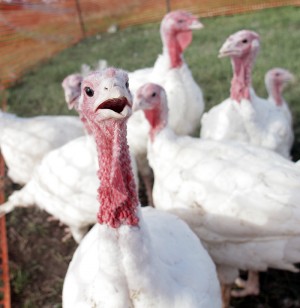
Travis Taylor | Lariat Photo Editor
Staff Writer
The gobbles of 100 fluffy, white turkeys ring out at World Hunger Relief Inc. as the nonprofit prepares for the flock to be sold this week for Thanksgiving feasts.
Each year in preparation for Thanksgiving, World Hunger Relief raises 100 turkeys in a manner unlike conventional meat company facilities, said Sarah Abdelmessih, livestock intern at the organization. The farm is almost sold out, Abdelmessih said, as customers place reservations on the birds in advance.
Turkeys will be butchered and processed Thursday and distributed Friday and Saturday.
Cargill Meat Solutions’ Waco meat production facility donates 100 of its turkey chicks to World Hunger Relief each year.
“Cargill does things on a much larger scale — thousands of turkeys,” Abdelmessih said.
Cargill has donated chicks to World Hunger Relief in the past, Abdelmessih said.
“They’ve been working really well with us lately to kind of see the comparison between conventionally raised turkeys and the ones that we raise here on the pasture,” Abdelmessih said.
World Hunger Relief raises its turkeys on a pasture and rotates the turkeys in fields of grass, she said. Their turkeys eat a combination of grass and non-medicated feed.
“It does add a lot to our livestock income because the turkeys are donated to us and the feed is donated to us, so there’s not very much expense for us,” Abdelmessih said. “We’re able to sell them pretty well. And it’s just good having 100 fewer birds raised in a conventional setting. I think it’s also been good having a relationship with Cargill, being able to talk to them more and see the differences.”
Abdelmessih said there is less fat in meat from World Hunger Relief’s turkeys because the animals are grass-fed, which she sees as a selling point.
“I think supporting happier raised animals in general is a really good thing,” she said.
In mass turkey production, the birds’ feed is typically medicated, Abdelmessih said. The animals are often kept together in a small space, housed in a concrete building, and they are not fed grass, she added.
“It’s definitely a lot less natural,” Abdelmessih said.
When World Hunger Relief receives their turkey chicks from Cargill, the turkeys’ back toes have already been cut off and the front of their beaks are burnt off. This is because when raised in a conventional meat production setting, the turkeys are housed close together and are liable to peck at each other and use their back claws to kick and scratch, which can harm the turkeys, Abdelmessih said.
“As far as being out here, they can’t pick bugs as well as I’d like them to because their beak is shorter,” she said. “And birds in general like to perch, especially at night when they’re sleeping they like to sit up on a perch and grab the bar with their legs. It’s a lot more comfortable that way. They’re less likely to trample other birds. But with the missing back toe they can’t do that anymore.”
Abdelmessih said World Hunger Relief can’t process the turkeys on the farm because United States Department of Agriculture regulations prevent it, so the turkeys are taken to a processing plant about three hours away. There, World Hunger Relief workers are able to watch what’s being done to their birds at the plant.
“I think that speaks highly of the processing plant; that we’re allowed to watch and see nothing sketchy is happening,” Abdelmessih said. “They’re not ashamed of how they’re taking care of those birds, so that’s good.”
Sarah Hess lives on the World Hunger Relief farm and is the wife of the organization’s executive director. Her family has purchased a turkey from the farm for the past three years.
“The turkey from the farm is a lot more gamey,” Hess said. “It has a lot more flavor because they’re eating the grass and the worms and all that stuff. They have a lot better diet. It adds a lot of natural earth flavors to the meat. It doesn’t taste like corn or grain.”
Hess said said the meat of World Hunger Relief’s turkeys is also leaner.
“The turkeys at the farm have a lot less fat, and the fat they do have is thicker and has a darker color and has a lot more flavor,” she said. “It’s not just fat for fat’s sake – it’s fat that has a lot of good flavor in it.”
Hess said there is a big difference to her in buying the farm’s turkeys as opposed to mass-produced turkeys.
“I live on the farm, kind of at the top of the hill, so when I look down I can see all these birds and I drive by them every morning to go to work,” she said. “I see them all out there in the field. It’s really nice to know where your food comes from. And if you spend time learning even a little bit where meat comes from, you really want to be a vegetarian, just because of gigantic factories where all the birds are kept in cages and given hormones where their breasts are so big they can’t walk, and the company has to throw away half their meat. That’s really gross. So it’s really nice to look down and see the birds are healthy. They’re eating grass on the farm. They’re happy. They’re having a good life.”



